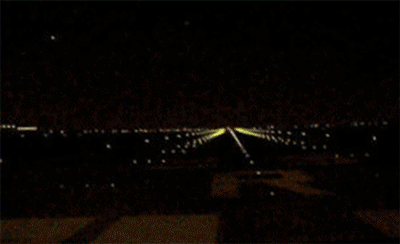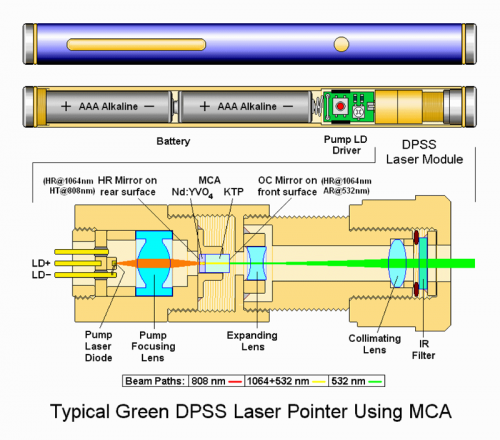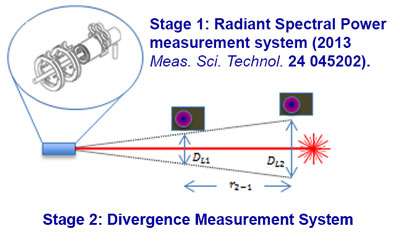Helping the judicial system understand laser strikes on aircraft

(Phys.org) —Joshua Hadler and colleagues in PML's Quantum Electronics and Photonics Division have devised a simple, accurate measurement system that can help law enforcement cope with a growing threat to aviation: laser attacks.
According to the Federal Aviation Administration (FAA), the number of reported incidents in which miscreants have aimed hand-held laser pointers at aircraft – with potentially dangerous effects on pilots' visual fields – has risen from 384 in 2006 to 3482 in 2012, the year in which it became a federal crime to do so. The trend shows no sign of abating, with preliminary totals for 2013 topping 4,000 .
The number of arrests and prosecutions has increased accordingly. "But in talking to experts, including Supervisory Air Marshal George Johnson, who is currently detailed to the Federal Bureau of Investigation (FBI), I found that the vast majority of prosecutions were failing, due in no small part to a basic lack of knowledge about the laser devices on the part of nearly everyone in the trial process, including lawyers, judges, and jury members," says Hadler, a physicist in the Laser Radiometry Project, and NIST's Laser Safety Officer. "What they needed was to be able to acquire and present quantitative data about a device's power and its effects at a specified range that could be used in the judicial process."
That need became even clearer in the spring of 2013 when Hadler was asked by the U.S. Attorney's office for the Eastern District of California to characterize a green laser pointer that two defendants had used to project a beam at a Fresno, CA police helicopter and at an emergency transport helicopter for a children's hospital.
Hadler had worked with the FBI before on calibrations of event recorders for aircraft cockpits, and he was already well known in the field for a widely reported study of power measurements he and colleagues conducted on 112 randomly purchased laser pointers. The results showed that 90 % of green pointers and 44 % of red pointers exceeded maximum power output specified in the Code of Federal Regulations.

"Many people saw these laser pointers as just inexpensive novelties or some kind of small bright flashlight," says Hadler, who undertook the survey following a growing accumulation of anecdotal evidence. "So in partnership with the NIST Safety Office, we developed a laser-pointer test rig that was simple and easy to use and would give us an accurate characterization of these devices so we could determine whether they were safe for use in a presentation or demonstration."
The report for the Fresno case also required information on how much the laser beam diverged. For this, Hadler used a pyroelectric laser camera. "That expanded the scope of our work," he says, "and provided divergence measurements necessary to calculate the exposure to the aircraft at the time of the incident. The FAA requires pilots to file a report of every laser incident report, noting color, duration, visual effects, visibility, and altitude. With that information, plus the weather and air quality at the time, I am able to provide a pretty decent calculation of the irradiance on the aircraft's cockpit." The trial resulted in a conviction.
The FAA has a framework in place for understanding the different minimum laser irradiance thresholds to induce a particular effect. The highest level, 100 microwatts or more per cm2, can cause flash blindness, persistent after-images, loss of night vision, and other problems. "The photoreceptors in the retina are completely overwhelmed, making it very hard to see anything accurately until the effect subsides," Hadler says. "It could take a pilot potentially minutes to recover." (If exposure exceeds 1 mW/cm2, there may also be retinal damage, which is possible within the approximately 0.25 seconds it takes for an exposed person to avert his gaze.)
The second level, at 5 microwatts per cm2, can produce glare that makes it temporarily very difficult to see anything in the field of vision besides the glare. The third range, at 50 nanowatts per cm2, may cause very bright, distracting spots that can be a substantial hazard when pilots are performing complicated operations.
In 2012, there were about 10 laser strikes per day in the United States, 94 % of which were made by green lasers. The vast majority occurred between 10:30 p.m. and 6:00 a.m.

Making a convincing legal case against perpetrators will require sophisticated measurements of both laser power and divergence. But sending every device involved in every case to NIST for characterization is not an optimal solution, Hadler believes. "Ideally, they should be able to get the data faster and cheaper. But at present, these sorts of measurements are simply not being done by forensics labs.
"Yet you can duplicate what we have in our lab for about $30,000, or the cost for a simpler setup could be as low as $10,000 – well within the budget of many facilities. One way to begin the process is that NIST would develop a Hand-Held Laser Characterization System that evaluates both beam divergence and spectral power distribution. We would calibrate it, take it to, for example, an FBI lab, install it, train the personnel, and then hand them the keys."
In addition, Hadler is scheduled to make a presentation on the idea next month at the annual science meeting of the American Academy of Forensic Sciences, where attendees include representatives from many different branches of law enforcement, as well as the heads of working groups in various standards fields.
"PML has a long history of providing measurement solutions to US industry, the military, and other government agencies in the area of optical power and energy," says Bob Hickernell, chief of the Quantum Electronics and Photonics Division where Hadler works. "This assistance to the law enforcement community is another example of NIST addressing an important public safety issue through measurement science and technology."
Provided by National Institute of Standards and Technology



















